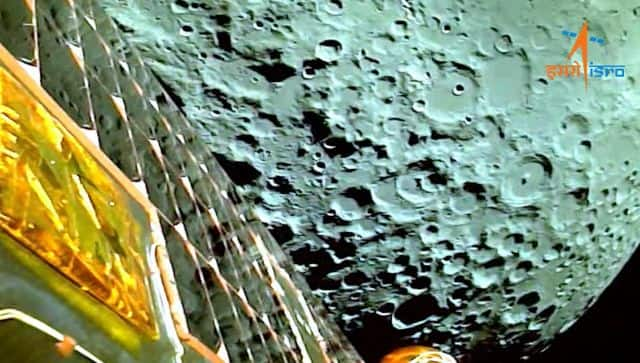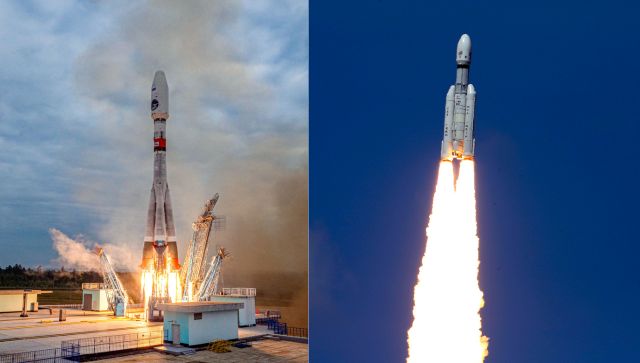The lander module (LM) of India’s Moon mission, Chandrayaan-3, has successfully detached from the propulsion module, paving the way for the planned soft landing on the lunar surface in the coming days. “LM is successfully separated from the Propulsion Module (PM). LM is set to descend to a slightly lower orbit upon a deboosting planned for tomorrow,” Indian Space Research Organisation (ISRO) said in a tweet today (17 August). A day back, Russia’s lunar spacecraft – Luna-25 – entered Moon’s orbit. The two spacecraft are headed for a soft landing on Moon’s south pole. While Chandrayaan-3 was launched on 14 July, Luna-25 lifted off from Russia’s Vostochny spaceport on 11 August. How are the two crafts different? Why was Chandrayaan-3’s journey to the Moon longer? We explain. Chandrayaan-3 vs Luna-25 ISRO Chandrayaan-3 is likely to attempt a soft landing on the Moon’s south pole on around 23-24 August as it will be lunar dawn at the landing site. Although Russia launched Luna-25 almost a month after India’s Moon mission, its touchdown is planned for 21 August, reported Reuters. It is likely to beat Chandrayaan-3 to become the first spacecraft to land on the Moon’s south pole.
As the craft entered Moon’s orbit on Wednesday (16 August), Russia’s space agency, Roscosmos, said in a statement, as per Hindustan Times (HT), “Luna-25 has entered the orbit of an artificial moon satellite! This was provided by two inclusions of the propulsion system of the automatic station. The first activation was performed by a corrective braking engine and lasted 243 seconds, the second by soft landing engines and lasted 76 seconds.” Luna-25 will circle the Moon for around five days before diverting course for a soft landing on the lunar surface, as per Reuters. ISRO had successfully completed the Lunar-Orbit Insertion (LOI) to put the spacecraft into the Moon’s orbit on 5 August, covering two-thirds of the 3.84-lakh-km journey to the lunar surface. A few days back, Luna-25 – Russia’s first Moon mission in nearly 50 years – sent its first images from space. These pictures came nearly a week after ISRO shared photographs clicked by the rocket’s Lander Imager (LI) Camera of the Earth and its only natural satellite. [caption id=“attachment_13007732” align=“alignnone” width=“640”] A view of the moon as seen by Chandrayaan-3 lander on 5 August. Reuters File Photo[/caption] Luna-25, which does not have a rover but only a lander with eight payloads, will study the lunar south pole and carry out scientific experiments for a year. Whereas, Chandrayaan-3 will last only one lunar day or 14 Earth days. ALSO READ:
Chandrayaan-3 vs Russia’s Luna-25: Why Moon’s south pole is so fascinating
Why India’s third Moon mission took so long Launched aboard its Soyuz rocket, Luna-25 has taken less time as compared to Chandrayaan-3 in its journey to the Moon due to a more direct trajectory. As per Indian Express, this was possible because of Luna-25 craft’s lighter payload and more fuel storage. While the lift-off mass for Luna 25 is only 1,750 kg, Chandrayaan-3’s is a total of 3,900 kg, with the lander module weighing 1,752 kg and the propulsion module weighing 2,148 kg. The launch vehicle of Chandrayaan-3 –
Launch Vehicle Mark-III (LVM3)
– is India’s heaviest rocket but not powerful enough to have propelled the mission on a direct path to the lunar surface. It has a lower fuel reserve due to which the spacecraft took a circuitous route to the Moon, noted the newspaper. After the launch, a series of manoeuvres were deployed to increase the orbit of the Chandrayaan-3 spacecraft so that it can gain velocity. With the successful completion of trans-lunar injection (TLI) in early August, ISRO slingshotted Chandrayaan-3 craft towards the Moon. A senior ISRO official told India Today previously, “The slingshot is aimed at ensuring that the spacecraft uses Earth’s gravity to increase its velocity travelling towards the Moon. It’s a complex dynamic of astronomy and physics.” Moreover, lunar dawn at the landing site of Luna-25 will take place earlier as compared to Chandrayaan-3. Thus, the craft is expected to land a couple of days before India’s mission. Where is Chandrayaan-3 now? The lander module – consisting of Vikram lander and Pragyaan rover – has separated from the propulsion module. The propulsion module will proceed with its journey in the same orbit, as per NDTV. Now, a series of deboost manoeuvres have been planned before attempting the soft landing on the Moon. Through this, the lander will be slowed down to position it in an orbit where the Perilune (nearest point to the Moon) is 30 kilometres and Apolune (farthest point from the Moon) is 100 kilometres, reported NDTV. Earlier, Chandrayaan-3 completed all its Moon-bound manoeuvres. After a successful manoeuvre on Wednesday which put the spacecraft into “an (intended) orbit of 153km x 163km”, the lunar probe took a step closer to the final touchdown.
A view of the moon as seen by Chandrayaan-3 lander on 5 August. Reuters File Photo[/caption] Luna-25, which does not have a rover but only a lander with eight payloads, will study the lunar south pole and carry out scientific experiments for a year. Whereas, Chandrayaan-3 will last only one lunar day or 14 Earth days. ALSO READ:
Chandrayaan-3 vs Russia’s Luna-25: Why Moon’s south pole is so fascinating
Why India’s third Moon mission took so long Launched aboard its Soyuz rocket, Luna-25 has taken less time as compared to Chandrayaan-3 in its journey to the Moon due to a more direct trajectory. As per Indian Express, this was possible because of Luna-25 craft’s lighter payload and more fuel storage. While the lift-off mass for Luna 25 is only 1,750 kg, Chandrayaan-3’s is a total of 3,900 kg, with the lander module weighing 1,752 kg and the propulsion module weighing 2,148 kg. The launch vehicle of Chandrayaan-3 –
Launch Vehicle Mark-III (LVM3)
– is India’s heaviest rocket but not powerful enough to have propelled the mission on a direct path to the lunar surface. It has a lower fuel reserve due to which the spacecraft took a circuitous route to the Moon, noted the newspaper. After the launch, a series of manoeuvres were deployed to increase the orbit of the Chandrayaan-3 spacecraft so that it can gain velocity. With the successful completion of trans-lunar injection (TLI) in early August, ISRO slingshotted Chandrayaan-3 craft towards the Moon. A senior ISRO official told India Today previously, “The slingshot is aimed at ensuring that the spacecraft uses Earth’s gravity to increase its velocity travelling towards the Moon. It’s a complex dynamic of astronomy and physics.” Moreover, lunar dawn at the landing site of Luna-25 will take place earlier as compared to Chandrayaan-3. Thus, the craft is expected to land a couple of days before India’s mission. Where is Chandrayaan-3 now? The lander module – consisting of Vikram lander and Pragyaan rover – has separated from the propulsion module. The propulsion module will proceed with its journey in the same orbit, as per NDTV. Now, a series of deboost manoeuvres have been planned before attempting the soft landing on the Moon. Through this, the lander will be slowed down to position it in an orbit where the Perilune (nearest point to the Moon) is 30 kilometres and Apolune (farthest point from the Moon) is 100 kilometres, reported NDTV. Earlier, Chandrayaan-3 completed all its Moon-bound manoeuvres. After a successful manoeuvre on Wednesday which put the spacecraft into “an (intended) orbit of 153km x 163km”, the lunar probe took a step closer to the final touchdown.
If all goes well, Chandrayaan-3 should reach the lunar surface on 23 August at 5.47 pm. With inputs from agencies
)